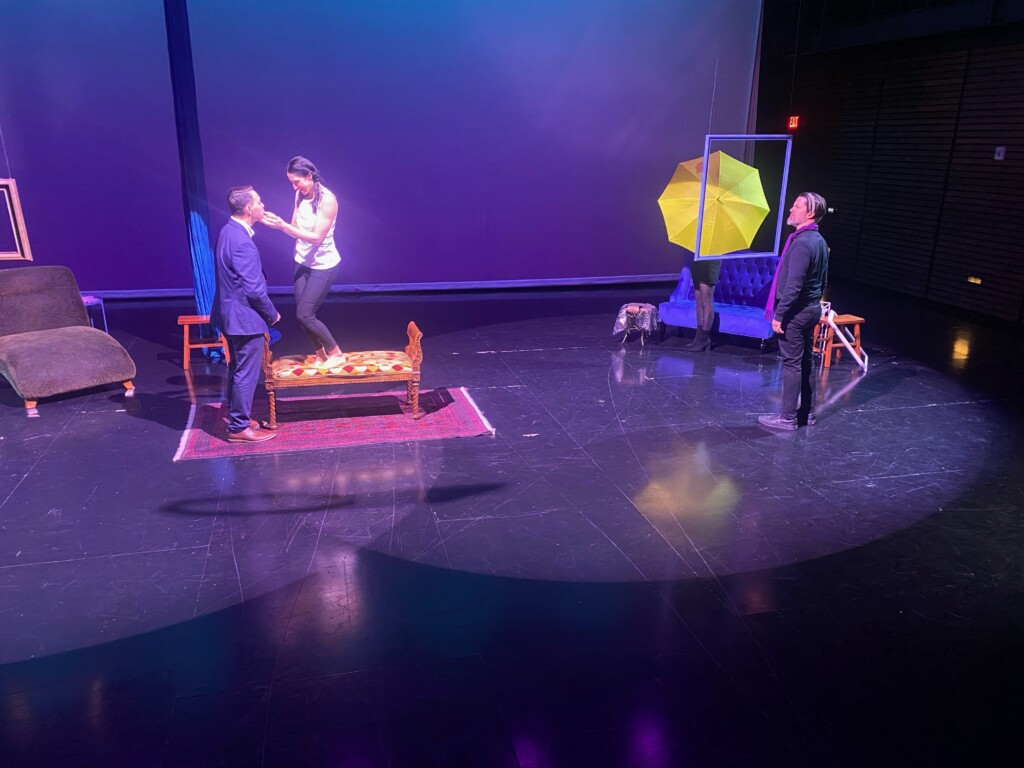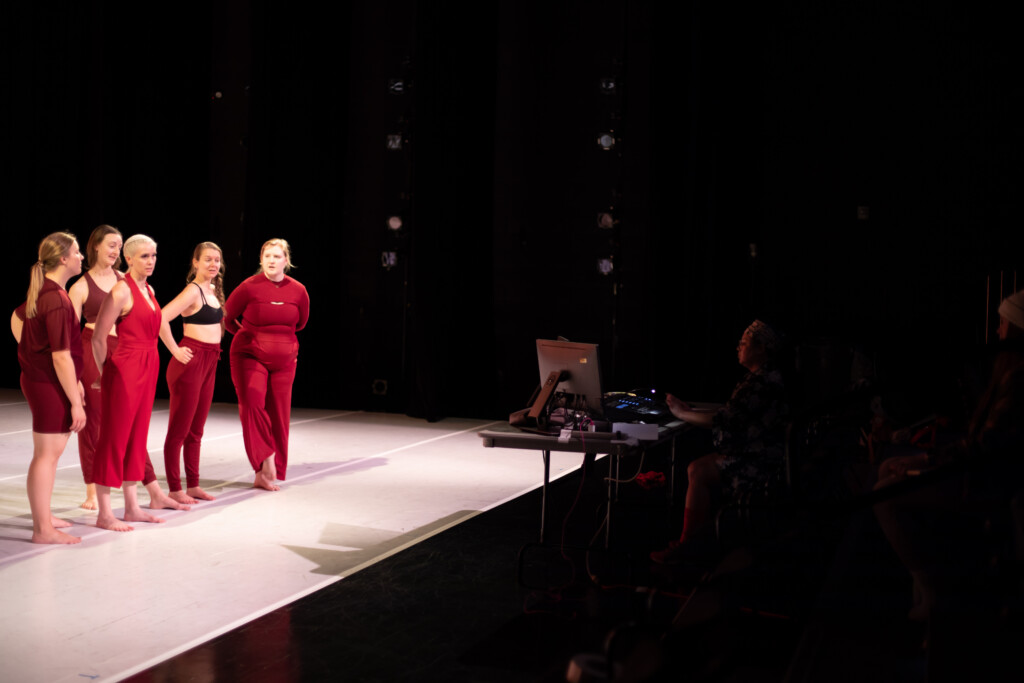WASATCH THEATRE COMPANY: MELANCHOLY PLAY
For the Wasatch Theatre Company production, Director Morag Shepherd took to heart Sarah Ruhl’s instructions for Melancholy Play: A Contemporary Farce: “Melancholy in this play is Bold, Outward, Sassy, Sexy and Unashamed. It is not introverted. It uses, instead, the language of Jacobean direct address.”
In a very smart, gratifying interpretation, the cast for this production valorized this rich, soul-inspired ode to melancholy. Kudos to a first-rate cast of actors who finely shaped the comedic and melancholic contours of their characters: Ariana Farber (Tilly), Amona Faatau (Frank), Ashley Wilkinson (Joan), Sam Torres (Frances), Barrett Ogden (Lorenzo) and Cellist (Alexandra Call).
Ruhl, one of the country’s best-known playwrights, wrote three plays within a two-year period (Eurydice, The Clean House and Melancholy Play), with melancholy as the thematic anchor. This chamber theater piece comes off like a wonderful European film, with light farce juxtaposed by doleful expressions of melancholy, along with a cellist providing the appropriate sound design to accent the tones of the minimalist stage set.
This is nostalgic melancholy, as characters gaze out of window frames on stage. The sense of longing varies from character to character. Lorenzo, the psychiatrist, was abandoned at a European confectionery, while separated twins Frank and Frances experienced their abandonment at a Scandinavian toy store. The characters reminisce variously about voyages, including Tilly, the main protagonist. The other characters are attracted to Tilly because they enjoy the emotions of melancholic yearning. For example, three of the play’s characters were abandoned by parents.
The self-effacing Tilly, who acknowledges that she is neither especially attractive or intelligent, is the quintessential melancholic. Tilly easily distracts her therapist, leaves behind her lover, and disrupts a relationship by moving from one encounter to another.
Shepherd’s direction teases out the best takeaways from Ruhl’s script. Ruhl’s conceptualization of melancholy is fascinating for its hybrid nature, cultivating the middle Buddhist path for equanimity and being inspired by game-changing beliefs about melancholy that occurred in the late 1500s and 1600s. Moving away from the Protestant belief that an individual’s conscience and melancholy were one and the same, influential volumes such as Robert Burton’s The Anatomy of Melancholy, published in 1635, argued that conscience and melancholy were not one and the same. Here, Ruhl is like the playwright-teacher for the soul.
Thus, rather than urge one toward shallow pretensions of happiness as the default antidote, by observing Tilly’s willingness to valorize her sadness, one can take to heart the ability to comprehend the world while carrying no qualms in feeling doleful about its fickleness and transience. Tilly feels immediately happy at her birthday celebration but the other characters find this sudden mood shift difficult to accept. Frank, her ex-boyfriend, likens Tilly’s sudden change in mood to a major storm capable of sinking her melancholy. But, melancholy also is contagious, as Frances becomes an almond – a brilliant example of magic realism. The characters drink Tilly’s tears so they can join Frances in her morphed state. Almonds when picked in the wild used to be bitter and toxic but then they mutated to become sweet, salty and tasty, making them ideal for agriculture. To wit: the almond is literally the perfect metaphor for melancholy.
Their collective action reunites them in their human form. The farcical and absurd dimensions nevertheless do not occlude the metaphorical substance of the play’s epiphany. Tilly’s earlier happiness has been now transformed into something more seasoned and fulfilling because of the experience with suffering. Indeed, Ruhl’s script wisely suggests that we should not rush to medicate sadness nor to insist that sadness is a condition to be avoided or repressed. Pleasantly, at the play’s end, the reuniting of the twins who were separated becomes its own solution to melancholy.
Wasatch Theatre Company will close its 25th season with a production of the Tony-Award-winning Broadway musical Fun Home (April 14-29), with score by Jeanine Tesori and book and lyrics by Lisa Kron. For more information, see the WTC website.
RDT LINK SERIES: JACLYN BROWN’S MATRIARCH
In her 2010 thesis for her master’s degree in The University of Utah’s modern dance program, Marney Debenham Schaumann wrote about how more women continue their performing careers as dance artists while having families and raising their young children. “Dancing women who choose motherhood engage in the ultimate act of improvisation and creation to balance both aspects of life, one that facilitates new levels of richness and understanding,” she wrote. “Motherhood and dance inform each other in ways that enrich and deepen the quality of both aspects of life and broaden a woman as an artist, creator, educator, teacher, and human being.”
This was beautifully realized in Matriarch, choreographed by Jaclyn Brown, for a recent production sponsored by the Repertory Dance Theatre’s Link Series. The 40-minute performance featured five dancers who are mothers and have continued their careers in various ways: Marisa Augustine-Crowder, LayCee Barnett, Jess MacDonald, Lacie Scott and Alicia Trump. Brown’s choreography enhanced the atmospheric music she selected including several tracks by Ocoeur (also known as Franck Zaragoza, an electronic musician from France). The movement juxtaposed feelings of youthful playfulness as well as subtle melancholy, occasionally punctuated with dancing swirls and twists. Sections moved smoothly from diametrically positioned expressions of grace and restraint to snappy, exuberant moments.
Matriarch is part of the thesis work Brown, who danced for seven years with RDT and is the mother of two children, has completed for her master of fine arts degree in contemporary performance and choreography at the University of Wisconsin at Milwaukee.
Each performer has been extensively involved in the dance community. Marisa Augustine-Crowder performed for the first time since the birth of her daughter, who is now eight months old. A graduate of Utah Valley University, she has performed with Wasatch Contemporary Dance and SALT Contemporary Dance and has choreographed for schools in Utah. A mother of twin daughters, Laycee Barnett, a Southern Utah University graduate, has been a company member with Kinuko Modern Dance Company, Myriad Dance Company, Wasatch Contemporary Dance Company and currently Creators Dance Project. Continuing her balancing of her roles as dancer and mother, Jess MacDonald returned to Utah and has performed with Fem Dance Company, Creators Dance Project, RDT’s Emerge, and currently is on contract with Wasatch Contemporary Dance Company. Likewise, Alicia Trump is an adjunct professor at Weber State University, an instructor for Ballet West’s I•CAN•DO program, and on faculty at Groove the Academy. She has choreographed for WSU’s Musical Theatre Program, presented her own choreography at the Rose Wagner Performing Arts Center, the Dance Mission Theatre in San Francisco, the College of Southern Nevada, the Dance in the Desert Festival, Red Rock Dance Festival, and Rocky Mountain Choreography Festival.
Lacie Scott, who also danced with RDT during Brown’s tenure at the company, has a daughter and two sons and enjoys dancing and teaching when she can secure a babysitter. Five years ago, for RDT’s Emerge, Scott and Brown set a piece to exemplify the balance of motherhood and life as a dance artist. Scott and Brown performed a duet in pajamas, accompanied by their daughters, respectively – Shae, who was then two and a half years old, and Layla, who was just two months old (the youngest performer to ever appear on an RDT stage). As Scott explained in an interview with The Utah Review at the time, “at the professional level, there are not too many dancing mothers and it can be a challenging, even controversial issue in some settings.”
Certainly, Brown’s Matriarch extends the realm of direct artistic insights into what life is like for dance artists who do find a balance to satisfy their roles at home and on stage.
RDT’s next Link Series offering will be Air Bird, an original, evening-length show featuring new compositions in dance, music, and theater (April 28-30). The company’s next subscription production will be Flight (April 20-22). For more information, see the RDT website.




